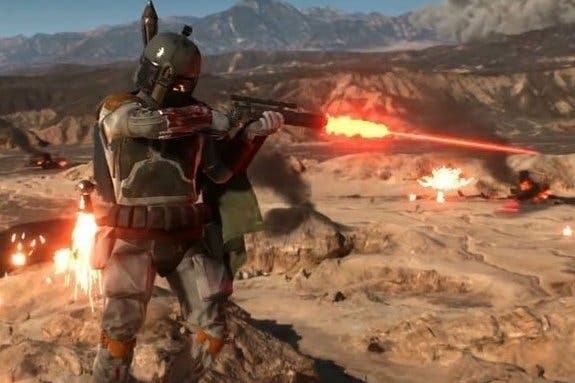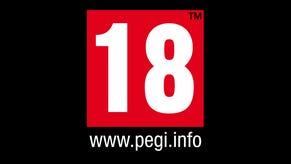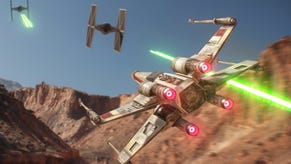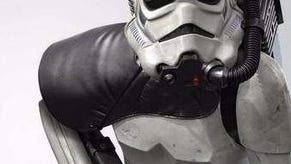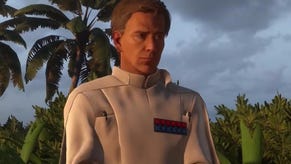Face-Off: Star Wars: Battlefront
Fully armed and operational - on all platforms.
When you look back at the launch of PlayStation 4 and Xbox One, one of the key titles holding the most promise was DICE's Battlefield 4. While resolutions fell under 1080p, the fact that we had a high-end PC game targeting 60fps on both platforms at launch showed real promise. Unfortunately, between connectivity issues and an unstable frame-rate in the game's larger multiplayer modes, the game's reputation took a hit when the dust settled. Now the task of rebuilding confidence in its products begins proper.
Over the past couple of years, its internal teams have been busy preparing two new titles, set for release within the next six months: Mirror's Edge Catalyst and of course, Star Wars: Battlefront. It's the year of Star Wars so it should be no surprise that hype around this title has been immense - but many reviewers have found the game lacking in content and depth next to Battlefield. While it's true that the game feels somewhat 'barebones', this focused design comes with some benefits. Primarily, reigning in ambitions has allowed DICE to create a beautifully polished experience from top to bottom.
Star Wars: Battlefront is available on PlayStation 4, Xbox One, and the PC and manages to push each platform to new heights in many technological disciplines, with some truly remarkable visuals. Using the latest iteration of Frostbite, we see a perfect mix of performance and visual quality throughout the experience. It's a game customised to run as smoothly as possible on consoles while delivering beautiful results.
Battlefront's real visual strength lies within its implementation of lighting and its relationship with in-gmae materials. Physically-based rendering is a key feature for the latest version of Frostbite and Battlefront takes full advantage of this feature to great effect. Lighting is natural and realistic in a way that exceeds many of its competitors. Between Battlefront and the recently released Need for Speed, it's clear that the PBR implementation in Frostbite is one of the best on the market.
This is aided through the use of photogrammetry; a technique for processing still images in order to produce a high resolution 3D mesh. Materials were scanned from key shooting locations used to create the original Star Wars trilogy in addition to props found within the Lucasfilm Cultural Arts Museum. This translates into worlds and characters that exude Star Wars in a way that has never before been seen. Stormtrooper armour has just the right amount reflectivity while the deserts of Tatooine feel remarkably accurate.
Of course, all of this would be for nothing if the end results didn't run properly or work as expected. We've seen accomplished visual results in games such as Assassin's Creed Unity but in the end, performance issues kept it from reaching its full potential on console platforms. Fortunately, the development team has delivered in spades with Star Wars: Battlefront. We're looking at - perhaps - the most polished console game DICE has produced to date.
This begins with the game's elegant menu system with its smart typeface choices, smooth transitions, and understated design. Simply navigating the menu is a treat here. This system is the glue that holds the package together and such smooth navigation helps build a solid foundation for the game itself. Loading times as well are reasonable between matches and take advantage of classic Star Wars music to ease the transition. Between rounds, loading is even hidden behind the tallying of your score effectively giving the impression of a game that seamlessly moves between each round.



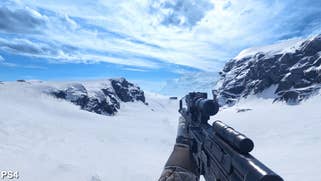


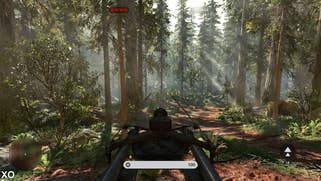
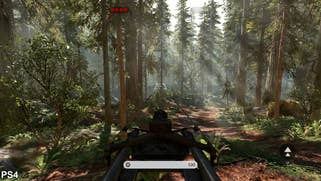
However, once in the game there are a few key things that become immediately apparent. First and foremost, there's the native rendering resolution. PlayStation 4 runs the game at 1600x900 while the Xbox One uses 1280x720. This is consistent with the two previous Battlefield titles but this time around, the results are moderately improved. Anti-aliasing on both consoles is handled by 'FXAA high' as it is labeled on the PC. There is an additional temporal AA solution available on the PC that hasn't made its way over to consoles though. Starting at 1080p, the lower you move down the resolution scale, the more impact there is to image quality in terms of shimmer and pixel-pop - 900p is a decent enough compromise for PS4, but 720p just feels like a step too far on Xbox One.
Speaking of PC, DICE has been kind enough to provide its full suite of options enabling a highly customisable image in the process. Alongside support for arbitrary resolutions, users can opt to manually adjust resolution scaling - this effectively provides built in downsampling without the need to rely on external tools. And it works in both directions too - an 83 per cent resolution scale basically gives you the 900p resolution found on PlayStation 4, useful for those with less capable graphics hardware. You can opt to run in a borderless window, full-screen, or straight windowed mode and can even adjust settings such as FOV or the amount of motion blur used.
Moving beyond image quality, how do the rest of the visuals stack up on each platform? Well, in an effort to optimise Battlefront for performance on consoles DICE has taken a rather nuanced approach. Rather than simply opting for a general preset based on the PC version, the evidence suggests that DICE has customised the console versions on a per-map basis. In one map, a variable could match the PC's high setting while, in another map, we'd see something that was lower than low.
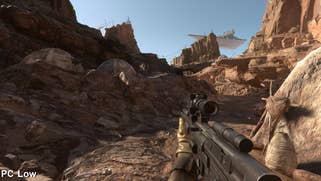


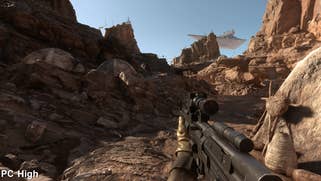

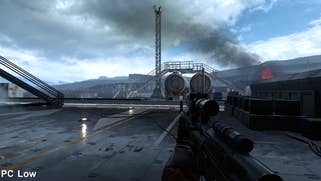
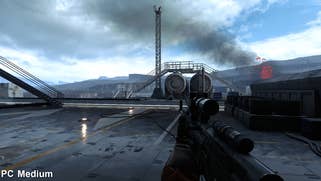


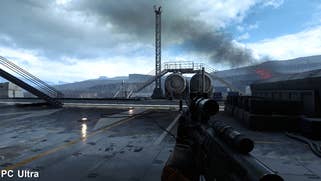
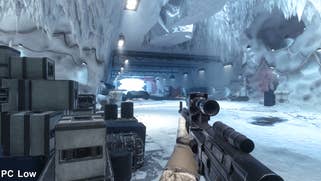
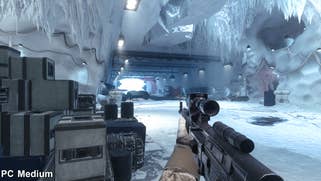
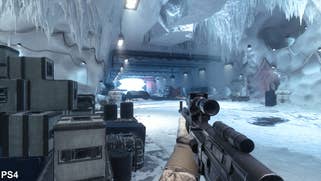
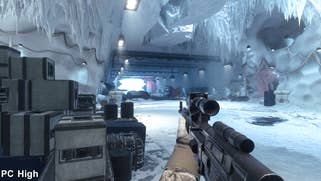
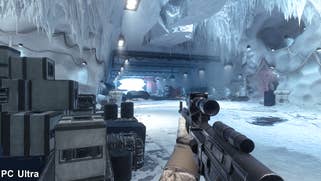
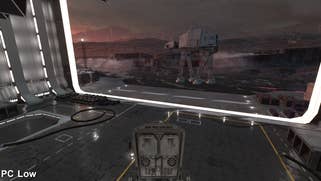
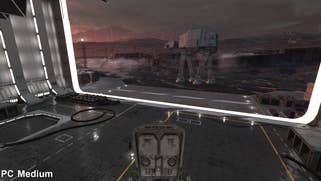



Textures play a huge role in Battlefront and in general, consoles appear to match the PC version's high setting. The PC's ultra setting basically provides even higher resolution textures in select circumstances though the two are fairly comparable during normal gameplay. Without comparing directly, it's difficult to find fault with the setting used on consoles but if you have the hardware, the extra clarity in select instances is a nice bonus.
As for texture filtering, it's clear from comparisons that the console versions of the game use the high setting, corresponding to 8x anisotropic filtering. As a high-end 60fps title, we were surprised to find that DICE took this into account but it really makes a tremendous difference here. Of course, the PC version can go up to 16x anisotropic filtering without issue.
Shadow quality is always one of the more demanding settings in a game like this but the console versions manage to perform reasonably well here. However, neither system seems to line up with one of the PC preset options, leading us to suggest that it falls somewhere around medium, but it can also match low and high in different circumstances.
Shadow filtering is of good quality, and the resulting shadows lack the artefacts we sometimes see with lower quality shadows. On PC, the higher settings simply increase the resolution of the shadow maps resulting in much sharper shadows as a result. As expected, bumping this up to ultra has a noticeable performance impact on the game particularly when pushing higher resolutions.
Then we have effects. The effects setting on PC determines both the volume and quality of elements such as smoke plumes and explosions, so the higher settings ultimately result in a much higher density of alpha effects. On consoles, we see this setting adjusted to fit each level. In some cases, we see results on par with the high setting on PC while, in other spots, we found it to be closer to the low setting instead. In all cases, however, we appreciate the existence of shadows for many particle effects. The smoke from an exploded grenade wafts smoothly over the terrain with soft shadows projected realistically against the ground. It adds a lot to the realism.
For post-processing effects, we once again see consoles operating with some variability. The highest quality ultra setting on the PC enables a beautiful bokeh depth of field effect used in both cut-scenes and menus. Consoles typically stick with the high setting, producing a soft Gaussian blur instead, but there are instances where the ultra setting pops up as well. This supports the theory that settings are adjusted on a per-map basis.
On all platforms, you will note the appearance of LOD pop-in across the terrain. The quality of the terrain is adjusted based on proximity but even using the ultra setting, the effect is easily observable. On consoles, based on our testing, we see a LOD distance that is not consistent with any of the PC presets. We noted instances where specific instances of distant geometry were consistent with the ultra setting on PC while other nearby formations would be consistent with high instead.
There is also an adaptive tessellation feature in play on all platforms that more gradually adjusts terrain quality as players approach. Rather than simply cycling between individual LODs, we actually see the terrain warp and skew as we move back and forth. It works well and isn't something we found distracting in the least, unlike the aforementioned LOD pop-in.
Now, while terrain rendering is of very high quality on consoles, it's clear that cutbacks were made in other areas. For example, the dense forest of Endor uses foliage placement that differs from all of the presets. More surprisingly, this is one area in which we discovered a difference between PS4 and Xbox One - there is more foliage rendered on Xbox while playing the Endor Survival map. Fortunately, there is still plenty of foliage to be found. We didn't actually notice the lack of foliage until comparing the two versions side by side, but it's fascinating to see how far DICE has gone to hit the 60fps target.
We mentioned previously that consoles use the FXAA high setting, providing reasonable edge smoothing without producing unwanted texture blurring. It works well enough here but the PC includes an additional higher quality option in the form of TAA or temporal anti-aliasing. This setting helps reduce shimmering and temporal artefacts in motion at the expense of sharpness. For those that want the added benefit of TAA without the blur, it is possible to pair this setting with SweetFX in order to sharpen the image. By using a value of 1.90 with the 'sharp_strength' found under LUMASHARPEN, we see an improvement in clarity without losing the benefits of TAA. This can be further improved by slightly increasing the resolution scaling option as well, though this has a greater impact on performance.
Lastly, we have ambient occlusion. Consoles appear to match the high setting on PC but even when using ultra, we still found the appearance of a dark blob around the player weapon somewhat distracting. It's interesting to note that the lowest setting on PC is a large step down from the other options. This is an option we highly recommend setting to high on the PC.
When it comes to performance, we feel DICE has made all the right moves. Star Wars: Battlefront operates at a very steady 60fps on both platforms. It is not locked, but it comes very close to delivering this top-end experience. To put it into perspective, Battlefront runs more consistently than most Call of Duty titles and comes reasonably close to matching the likes of Halo 5 or Metal Gear Solid 5.
The areas where we encountered slowdown are curious. On PS4, Battlefront manages to hold a very steady level of performance during even the largest of battles online. The occasional dips show up once in a while, but overall, it's very smooth. That said, in testing the single-player portions of the game, we actually ran across a couple instances where slowdown consistently appeared leading to dips into the mid-40s at the absolute lowest. This is not representative of general performance, however.
On Xbox One, performance slips somewhat lower at times during the largest of battles. During an average play session, the experience still comes close to achieving its objective, but certain areas trigger dips under 60fps. It's not as smooth overall as PlayStation 4, but for a large scale multiplayer title, the performance is still a huge improvement over Battlefield 4. As for the PC, well our main test machine here was equipped with a GTX 780 and a Core i5 3570K overclocked to 4.5GHz. We were able to achieve a very stable 60fps at 1080p on our system using ultra settings for everything except shadows, which we dialled back to medium.
The best we could do with this hardware set-up at 1440p was to drop down to high settings and drop resolution scale to 90 per cent (upscaling from 2304x1296). This still provided a great experience, but generally speaking, those looking for an uncompromised 1080p ultra experience will require a GTX 970 or an R9 390. We're still working on a more extensive PC hardware test, but right now, our feeling is that there's been a lot of optimisation since the beta but AMD still commands overall performance leadership.
Star Wars: Battlefront - the Digital Foundry verdict
Ultimately, what we have here is a highly optimised version of Battlefront on all three platforms. Console optimisation is especially impressive: various settings are adjusted on a per-map basis in order to squeeze the best performance out of the game in all circumstances. When possible, we see consoles match the PC's high preset, but in other situations, we see settings adjusted to lower values in order to keep performance soaring.
Between the two console versions, both are of great quality, but the PS4 version comes out on top with a more stable frame-rate and a higher resolution. You shouldn't feel bad about playing on Xbox One, as it's a great release let down only by its reduced image quality, but if you have the choice, the PS4 version is the way to go. Of course, if you'd rather play on PC, you'll be able to enjoy further improved visuals all around with plenty of customisation options. It's a great release, scaling beautifully across a range of hardware.
It's clear that Star Wars: Battlefront sets a new standard when it comes to capturing the essence of the franchise in a videogame format. There really is nothing out there that looks quite this good or feels this true to the source material. The overall package may be rather 'barebones' compared to the multitude of other shooters on the market today but it's still a blast to play. With its slick 60fps presentation and solid mechanics Battlefront stands alongside Nintendo's Splatoon as a shooter that can appeal to all ages and skill levels - let down only by its initial lack of content. If you're hungering for some multiplayer Star Wars action that doesn't demand hundreds of hours to master, Star Wars: Battlefront is a good bet on all platforms.
